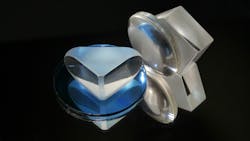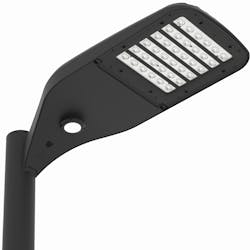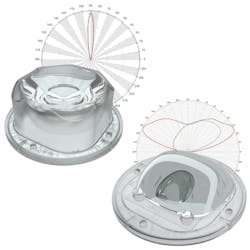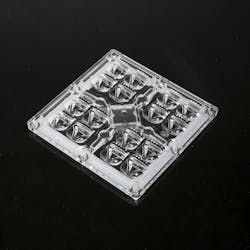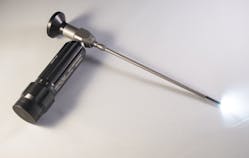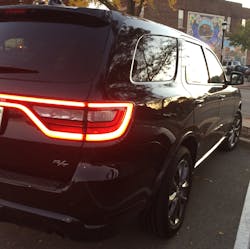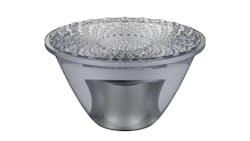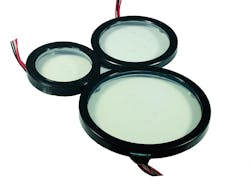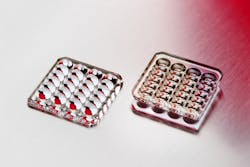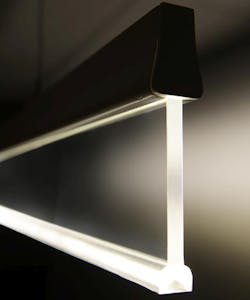Back in the day of legacy light sources, optics were simple. In a high-pressure sodium street (HPS) light, for instance, the secondary optic or lens does little more than protect the lamp from damage and perhaps lend some diffusion properties. In most LED-based street lights, the secondary optics are responsible for delivering the prescribed beam pattern from an array of point sources. Similarly, solid-state lighting (SSL) optics are critical in delivering quality of light in museum applications, area lighting, high-bay applications, and even specialty niches such as horticulture or automotive. Optics manufacturers continue to expand their portfolios in terms of materials and the function of the optics model at hand. SSL product developers will find off-the-shelf models for many popular LEDs designed for specific applications. Conversely, several optics manufacturers are ready to partner with developers in designing custom optics for a specific luminaire concept. Let’s have a look at some recent optics products from around the globe to get a good understanding of the range of options.
A.L.P. Lighting LexaLite optics
A.L.P. Lighting Components is probably the largest optics manufacturer that you don’t know is an optics manufacturer. This sister company to component distributor Bill Brown Sales specializes in manufacturing most any component or subsystem that SSL product developers need to get a new luminaire to market. Under their LexaLite brand, A.L.P. does custom injection molding of acrylic (polymethyl methacrylate, PMMA), PC (polycarbonate), and silicone optics in most every size and using a broad portfolio of base materials. As we have covered in technical feature articles, there is no easy choice when it comes to optics materials, and the correct answer is application dependent. The nearby photo depicts an A.L.P. silicone optic designed for a rectangular LED array application such as a street light. The array optic is shown adjacent to a Mirada outdoor area luminaire from LSI Industries, an A.L.P. customer. LSI says the A.L.P. silicone optic delivers 93% light transmittance across the human visual spectrum, and will not degrade with ultraviolet (UV) exposure. Silicone as a material also can serve as a gasketing agent for ingress protection (IP) and can operate reliably in high temperature environments.
Khatod SIO3 Junior silicone lens
As mentioned earlier, advances in optics have come courtesy of material advances and then the ability of the optics maker to deliver a large number of variants of an optic family for different applications. Khatod was an early innovator in silicone optics. Silicone remains more expensive than PMMA or PC, but in many applications the cost premium is justified. Moreover, since silicone remains slightly flexible, there are molding options that just would not work with PMMA or PC such as undercuts. Khatod’s latest additions to its silicone family — the SIO3 Junior — have come in a new smaller size measuring 90 mm in diameter and ranging from 15.3–35.31 mm in height. The height is dependent on the optics features that can deliver the various beam patterns in the portfolio. The SIO3 Junior optics are designed for use with chip-on-board (COB) LEDs that have a light-emitting surface (LES) diameter from 9–23 mm. The range of beam patterns offered and the target applications are quite broad. For example, Khatod offers optics that deliver the street and area Type I, II, III, IV, and V beam patterns that, while no longer specified by the IES (Illuminating Engineering Society), are still widely used by lighting practitioners. Khatod also offers optics for spot and flood lighting ranging from a 15° spot pattern to a 90° flood pattern.
LEDiL MX Series
The MX Series from LEDiL is an example of an LED optics family that has continued to expand and evolve on a pace that matches changes in the packaged LED space, such as the move to CSP (chip-scale package) LEDs. The MX Series products measure 90×90 mm. The first models brought to market several years ago were in the 2X2MX family designed for four high-power or ultrahigh-power LEDs. LEDiL has since maintained the footprint of the original MX while introducing new models that support larger arrays of smaller LEDs. The latest model is the 16MX that is designed for 16 CSP LEDs in a 4×4 configuration. Across the MX family, the products are designed for high-output applications such as street and area lighting and industrial high-bay lighting. For instance, LEDiL offers versions that deliver all of the aforementioned IES beam patterns for street lights and parking area lights. LEDiL had first supplied the MX optics using PMMA materials that are rugged and cost effective for the target applications. And the company now offers the products in silicone versions mainly for installations where the luminaires will be exposed to high ambient temperatures. Even for the PMMA models, LEDiL integrates a silicone gasket with the optic that provides ingress protection, sealing the luminaire from dirt or water. LEDiL is also one optics manufacturer that has specifically targeted horticultural lighting. In a webcast last year, an executive said that optics inherently introduce slight losses, but an optic matched to the plant canopy to be lit improves overall uniformity and horticultural efficiency.
Fraen Zoom Optics
We most often think about optics as one of the components of a luminaire designed for general illumination, and certainly that’s a huge market for many of the products featured in this article. But other applications for optics abound — for instance, in the life sciences area. Fraen serves customers across the spectrum of applications with catalog products and custom optics. For example, Fraen won an LEDs Magazine Sapphire Award in 2018 for an optic embedded in the Acera handheld light source with the optic focusing the light into a fiberoptic. The product was designed for use in endoscopic instruments and similar applications. And the handheld tool utilizes in part the color-mixing, zoom-optic technology that had garnered the company a Sapphire award the prior year. Just recently, Fraen announced that it had pursued a patent case with the US International Trade Commission (ITC) focused on other manufacturers importing products to the US that infringe the technology behind the color-mixing zoom optics. As mentioned earlier, the technology is widely applicable and has been used in entertainment applications at football games and concerts to deliver dynamic color lighting. The ITC has essentially banned import of infringing products excepting manufacturers that have a license agreement with Fraen.
Luminit Optical Diffusers
Just as optics have no bounds in terms of application, we should also realize that there should be no presumption of what they look like or how they function. It’s easy to look at typical lenses and to instinctively understand the function. But optics in other forms can be incredibly effective, such as the Luminit Optical Films. The company essentially makes light-shaping diffusers realized in thin flexible polycarbonate sheets that serve as a substrate for the Luminit micro optics. One application, for example, is to apply a sheet to LCD panels used in challenging visual environments. In an automotive cabin, for example, the Luminit film applied to the display can effectively increase the brightness. Luminit has also supplied other functions in the auto — its micro-optic technology has been used in an injection molding process to realize auto taillights (pictured nearby) that deliver better visibility. Luminit has also formed a joint venture with RiT Display intended at developing a variety of automotive-centric optics. Working in conjunction with RiT Display, the Luminit technology will be applied in places such as a projector for a heads-up display (HUD).
Gaggione Silicone Collimators
Moving back to general illumination, Gaggione has a somewhat unique approach to optics for directional lighting such as downlights and tracklights. The company’s Silicone Collimator family of products has been popular in the 67-mm-diameter version. This past year, Gaggione brought out a more compact 45-mm line — the LLC79X7 family — that would enable slightly smaller luminaires yet use the same ecosystem of support products such as COB LED holders. The products rely on both refractive and reflective properties to deliver a precisely controlled beam and could only be realized in silicone. Even in the smaller size, Gaggione says the new collimators match the beam homogeneity and efficiency of the 67-mm products. The company announced the 45-mm family with three fixed-focal-length models: the LLC79N7 Narrow, LLC79M7 Medium, and LLC79W7 Wide. The actual beam spread depends on the specific LED utilized and the optic is compatible with 6- and 9-mm LES COB LEDs and 2–4-mm high-power discrete LEDs. For example, FWHM (full width at half maximum) beams are 14°, 25°, and 44° respectively when used with a 6-mm COB LED.
LensVector Dynamic Beam Shaping
The ability to change the focal length of a luminaire easily can be a game changer in some applications such as retail where merchandise displays are changed regularly. Optics vendor LensVector has a technology that enables the beam of a luminaire to be changed dynamically utilizing wireless-based control. The technology centers around the use of liquid-crystal technology in the lens and a simple two-wire control interface to adjust the beam. The adaptability does add cost, but in the right applications saves money due to the elimination of the maintenance cost to adapt lighting. Most recently, LensVector announced new products that slightly lower the cost of entry into the dynamic beam space. The company’s first products could adjust over the range of 5–50°, and was offered in 48- and 65-mm versions. At LightFair International this past spring, LensVector added lower-cost 15–35° models and smaller 35-mm lenses. We also recognized company founder Tigran Galstian as our Sapphire Awards Illumineer of the Year for 2019.
Auer Lighting Multi-Lens Arrays
We have discussed a variety of optics materials thus far relative to use with LEDs, but one is missing. Care to guess what it is? The answer is glass. Auer Lighting is a staunch supporter of glass optics. The company contributed an article on the topic a number of years back. Auer has a comparison table on its website that suggests that glass has equal or better optical efficiency to the alternatives, is more durable, exhibits no optically-adverse aging effects over time, and can be used in temperatures as high as 300°C. Glass does generally cost more than other options, but there are many applications that can benefit from the properties of glass. The newest optic introduced by Auer is a family of Multi-Lens Arrays (MLAs). As the name suggests, the arrays have individual optic elements for each LED in an array. Auer offers the products in round and rectangular form factors and targets the MLAs at applications with extremely high light levels and long operating hours — both of which equate to a lot of heat. Examples include digital projectors and beam shaping for stage and studio. The company says the optical properties will remain consistent over the life of a product. Of course, there are many other applications that need good high-heat performance but don’t necessarily rely on an array of LEDs. Auer also offers a number of glass optics for individual LEDs that deliver reflective, refractive, and hybrid effects.
QuarkStar Edge-X
At the end of the day, optics in SSL applications serve the primary task of controlling beam distribution. Our final company in this article takes that task to a new level. QuarkStar is a late-stage startup company with a business plan focused on licensing optics technology to luminaire makers. The company, however, has developed some compelling demonstration optics, especially Edge-X for general illumination applications. The Edge-X optics combine light guide functionality that serves as a way for photons to travel from an LED light engine to the edge of the optic, where the company’s patented technology then forms the desired beam pattern delivering light just where it is needed. The nearby image shows the transparent planar light guide between the light engine and the beam-forming edge optics. Feilo Sylvania became the first SSL manufacturer to license the QuarkStar technology earlier this year.
Keep us up to date on your latest LED and SSL products by e-mailing press releases, along with a high-resolution image, to Carrie Meadows for our Company Newsfeed on the website. It’s the first place we go when researching a Focus On article!
